Introduction: Where the Earth Reaches for the Sky
Have you ever looked up at a tree so tall that it made your neck hurt — and you still couldn’t see the top? Now imagine a tree as tall as a 35-storey building, older than most empires, and quietly breathing life into our planet every single day. Welcome to the world of Earth’s tallest trees — the natural skyscrapers that define forests across continents. These trees are not just tall; they’re marvels of biology, endurance, and balance, pushing the limits of how high life can grow.
How Do We Measure a Tree’s Height?
Before declaring any tree the “tallest in the world,” scientists must measure it carefully — and that’s harder than it sounds!
1️⃣ Laser Rangefinders and LiDAR
Modern researchers use LiDAR (Light Detection and Ranging) to scan forests from planes or drones. This helps locate exceptionally tall canopies before visiting on foot.
2️⃣ Climbing with a Tape Drop
For precise measurement, climbers ascend the tree, drop a tape measure from the top, and record the exact distance to the base. This method confirmed the height of record-holders like Hyperion and Menara.
3️⃣ Challenges
-
Trees often grow on slopes, making it hard to find the true “base.”
-
Leaning trees may appear taller or shorter depending on the angle.
-
Many tallest trees are in protected or secret areas to prevent damage from tourists.
The World’s Tallest Tree: Hyperion
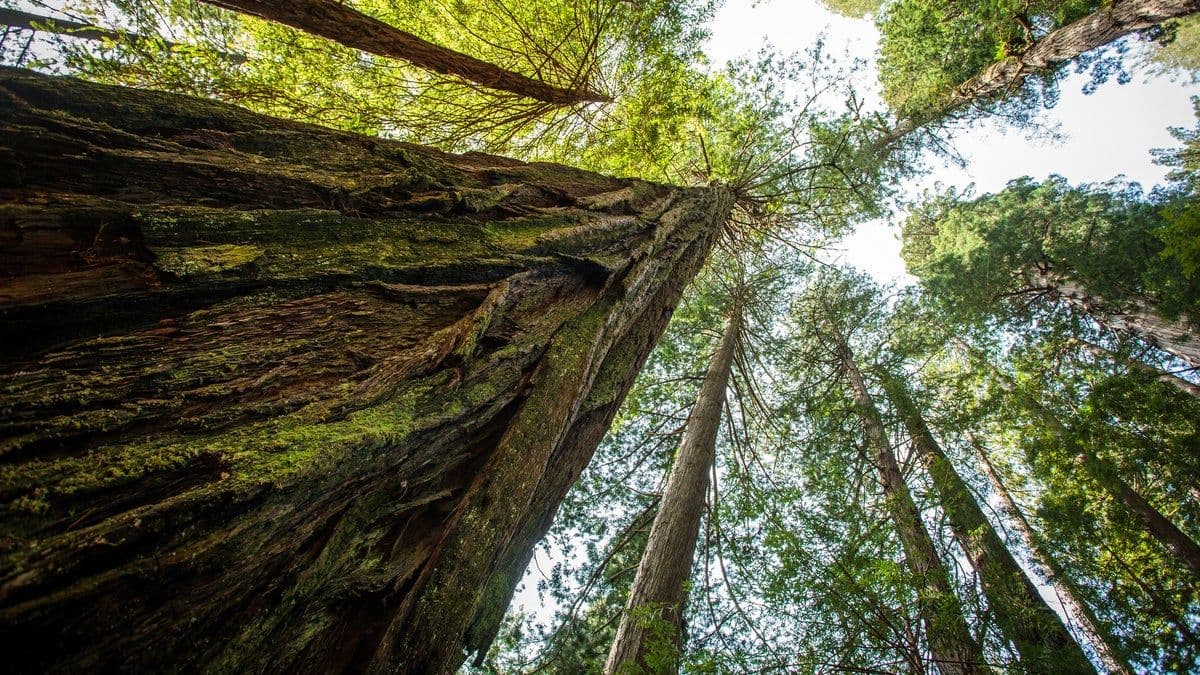
Name: Hyperion Species: Sequoia sempervirens (Coast Redwood) Height: 116.07 meters (380 ft 9.7 in) Location: Redwood National Park, California, USA Discovered: August 2006 by Chris Atkins & Michael Taylor Age: ~600–800 years
Hidden deep in a Californian forest, Hyperion rises above the canopy like a living mountain. Its exact location is kept secret by the U.S. National Park Service to protect it from damage caused by curious visitors.
Redwoods like Hyperion thrive in the temperate rainforests of Northern California, where fog provides constant moisture. Their bark is thick, fire-resistant, and rich in tannins — making them naturally protected from disease and insects.
Hyperion isn’t just a tree — it’s a monument to patience, persistence, and perfect conditions.
Source: Guinness World Records, Wikipedia
The Redwood Dynasty – Giants of California
The coastal forests of California are home to the tallest living trees on Earth. Each one stands taller than most skyscrapers and older than many cities.

These trees form the “Redwood Cathedral” — dense forests that capture fog, shelter thousands of animal species, and absorb enormous amounts of carbon dioxide. A single mature redwood can store up to 250 tonnes of CO₂ — more than most forests the same size!
Source: Wikipedia: List of Tallest Trees
The Tropical Giant – Menara Tree, Malaysia

Name: Menara Species: Shorea faguetiana (Yellow Meranti) Height: 97.58 m Location: Danum Valley, Sabah, Malaysia Discovered: 2019 Claim to fame: World’s tallest tropical and flowering tree
Unlike the redwoods, Menara grows in a humid rainforest, competing for sunlight in a dense green canopy. Its trunk rises perfectly straight before exploding into a wide umbrella of leaves.
Scientists had to climb the tree to confirm its height — a daring feat involving drones, ropes, and lasers. Menara also proved that tropical trees, long thought shorter than temperate conifers, can reach astonishing heights under the right conditions.
Source: Wikipedia: Menara Tree, One Tree Planted
The Eucalyptus Empire – Giants of Australia
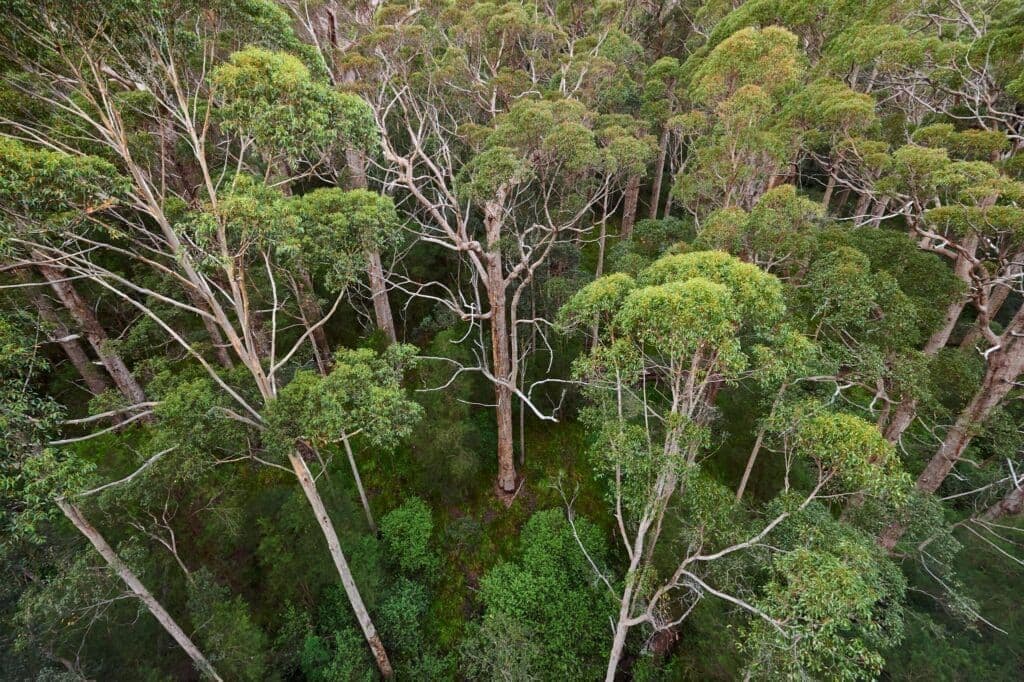
Australia’s Eucalyptus trees are among the tallest flowering plants on Earth. Unlike the conifers of North America, these hardwoods grow in warm, wet regions and rely on strong lignin fibers for support.

Centurion, named after its hundred-meter mark, is the tallest known flowering plant. It survived multiple bushfires, storms, and logging attempts, now carefully protected as a natural treasure.
Source: Wikipedia: List of Tallest Trees
Giants of the Pacific Northwest
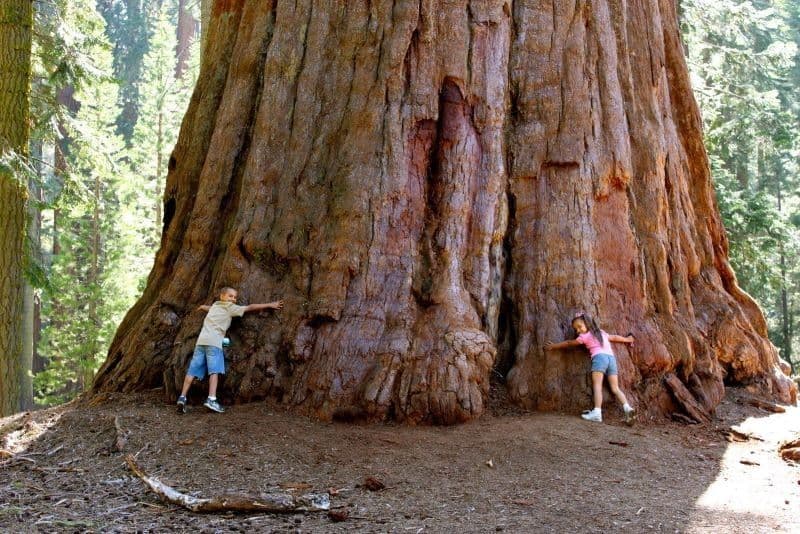
The foggy coasts of Oregon, Washington, and British Columbia host some of the world’s most awe-inspiring conifers.

These trees thrive in cool, rain-drenched forests, growing taller each year thanks to stable moisture and rich volcanic soils. The Douglas-fir, in particular, is known for its strength — its wood once built entire cities and ships, yet its living form towers far beyond human architecture.
Asian and Amazonian Giants
While North America dominates in height, Asia and South America are home to spectacular newcomers:
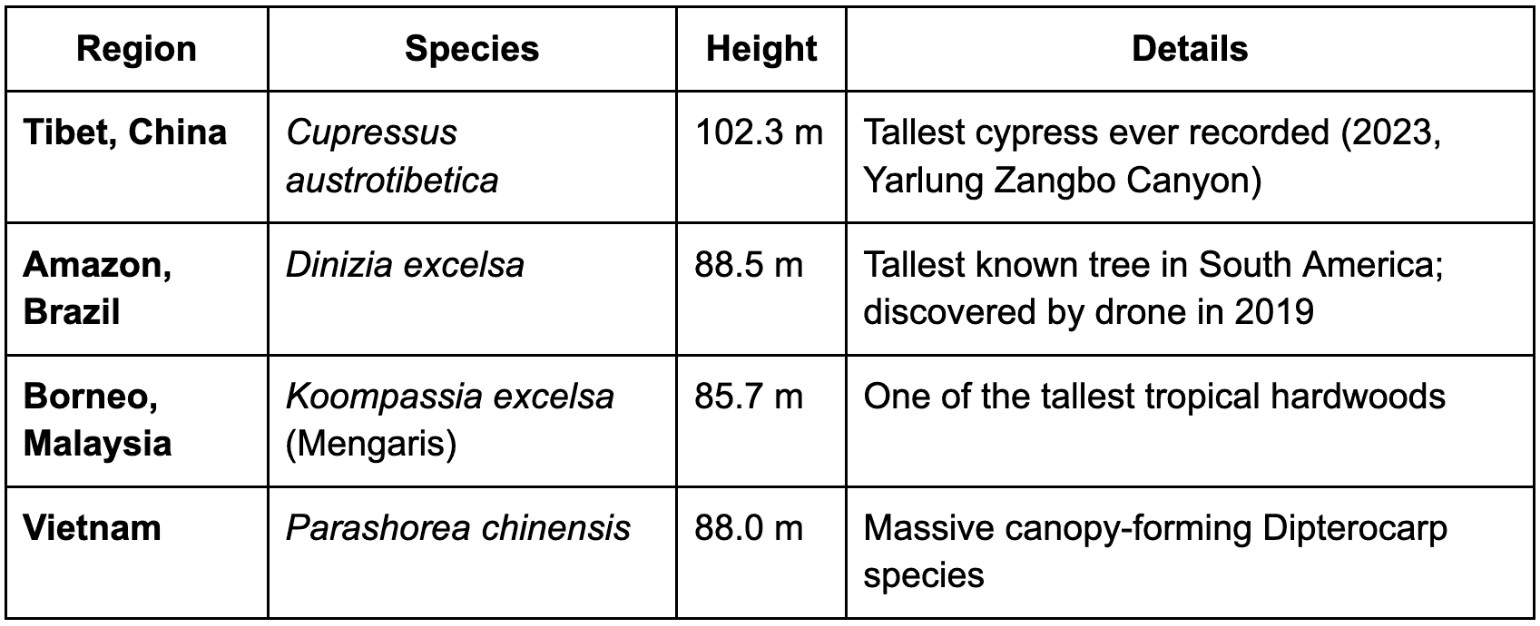
These tropical trees remind us that height isn’t limited by latitude — it’s shaped by competition, water, and time.
How Do Trees Grow So Tall?
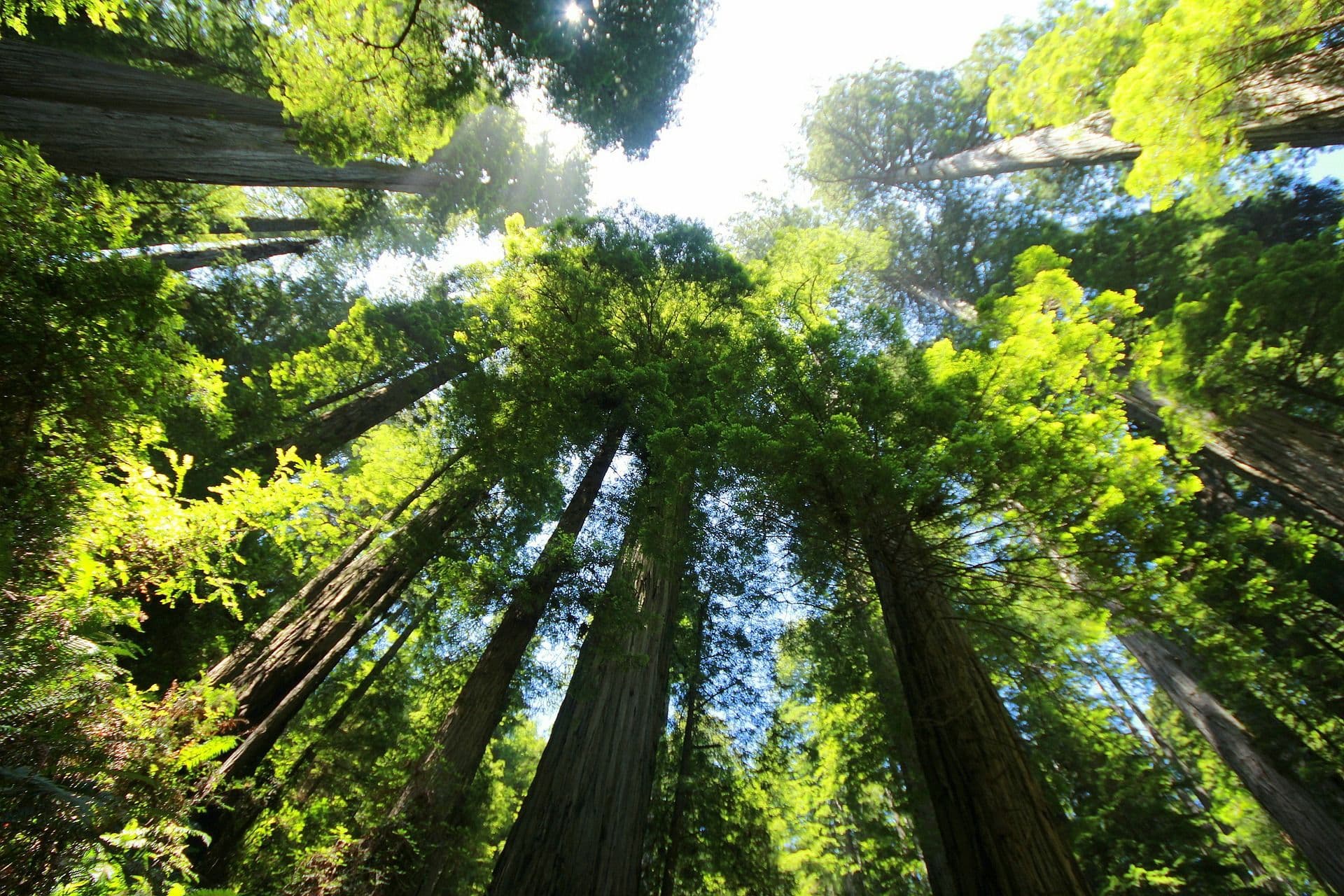
Tree height is limited by physics, but nature always finds a way to push boundaries. Here’s how these giants manage to touch the clouds:

Scientists estimate that 130 meters is near the absolute biological limit for trees under Earth’s gravity and atmosphere.
(Source: Koch et al., Nature, 2004 – “The limits to tree height”)
Why the Tallest Trees Matter
The tallest trees are more than record-breakers — they are ecosystem pillars.
Carbon Storage Powerhouses: A single giant redwood can store up to 1,000 tonnes of CO₂ over its lifetime.
Biodiversity Hubs: Their canopies form multi-story homes for birds, insects, mosses, and even small mammals.
Water Cycle Regulators: Tall forests condense fog into droplets that drip down as natural irrigation — known as “fog drip.”
Climate Archives: Their rings record centuries of droughts, rains, and atmospheric changes.
Spiritual and Cultural Symbols: In indigenous traditions, tall trees often represent the bridge between Earth and Sky, reminding us of our place in nature’s design.
The Science of Limits
Researchers studying tall trees often ask: Why don’t they grow taller? The answer lies in physics and energy:
-
At great heights, the pressure required to move water upward becomes too high.
-
The top leaves risk dehydration and collapse if water columns break.
-
Wind load increases exponentially with height.
-
Nutrient transport becomes inefficient beyond ~120 meters.
These constraints create a natural balance — trees grow as tall as they can, not as tall as they want.
The Fragile Future of Giants
Most record-holding trees are now under threat from:
Climate change – causing drought stress and altering fog patterns.
Logging and land conversion – removing protective forests.
Tourism and trampling – compacting soil and damaging roots.
Fire and pests – especially in regions like California and Tasmania.
That’s why organizations and communities worldwide — including CATCH Foundation in India — work to protect and plant native trees that can thrive for centuries.
While India’s trees may not reach 100 meters, our urban forests and Miyawaki plantations follow the same principle: create resilience, diversity, and life that endures.
Summary Table: 20 Tallest Known Trees
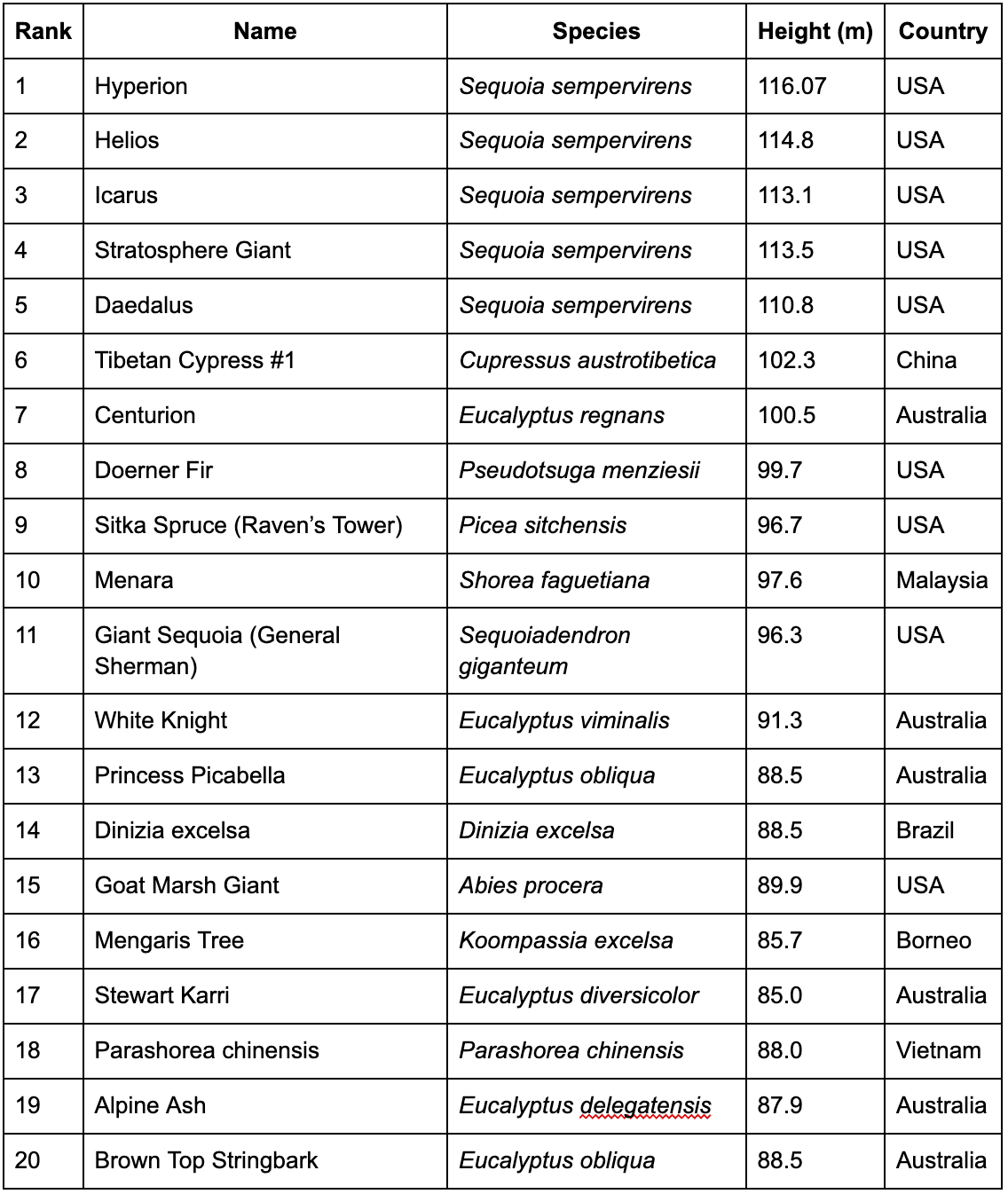
(Source: Wikipedia, Guinness World Records, OneTreePlanted, JagranJosh)
Lessons from the Sky-High Trees
🌿 Height comes from harmony, not haste. Trees grow tall only when the ecosystem around them supports balance.
🌦️ Every meter tells a story. Each trunk ring records rain, wind, sunlight, and survival.
🌍 Protecting them protects us. These giants anchor biodiversity and climate stability.
At CATCH Foundation, we may not plant redwoods — but our mission is the same: to grow forests that stand tall in purpose, if not in height.
References
-
[Nature Journal – Koch et al., “The limits to tree height,” 2004]
Frequently Asked Questions (FAQs)
1. What is the tallest tree in the world right now? The world’s tallest tree is Hyperion, a Coast Redwood (Sequoia sempervirens) in California, USA. It stands 116.07 meters (380.8 ft) tall and was discovered in 2006. Its exact location is secret to prevent human damage. (Source: Guinness World Records)
2. How tall can trees grow on Earth? Scientists estimate the biological limit of tree height to be around 130 meters (426 ft). Beyond this, gravity and water transport make it nearly impossible for sap to reach the top leaves efficiently. (Source: Koch et al., Nature, 2004)
3. What makes redwoods grow so tall? Redwoods thrive in moist, foggy climates that provide constant water. Their bark resists fire and insects, and their root networks interconnect for stability. This combination allows them to grow taller than any other species on Earth. (Source: National Park Service, USA)
4. Which country has the tallest tropical trees? Malaysia holds the record for the tallest tropical tree — the Menara Tree (Shorea faguetiana), standing 97.58 meters tall in Sabah’s Danum Valley. It’s the tallest known flowering tree on the planet. (Source: One Tree Planted)
5. What is the tallest tree in India? India’s tallest known tree is a Eucalyptus in the Silent Valley National Park, Kerala, measuring around 76 meters (249 ft) tall. The species Eucalyptus grandis is not native but was introduced for timber and shade. Native species like sal (Shorea robusta) and teak (Tectona grandis) are shorter but ecologically vital. (Source: Jagran Josh)
6. How do tall trees help the environment? Tall trees act as climate regulators — storing carbon, creating shade, and generating rainfall through transpiration. Their canopies support birds, mosses, insects, and even small mammals, forming vertical ecosystems essential for biodiversity.
7. Why are tallest trees important to conserve? Because they take centuries to grow, but only minutes to destroy. They hold carbon, stabilize soil, and protect thousands of species. Protecting these trees means safeguarding the lungs and history of our planet.
